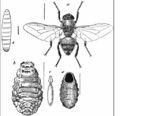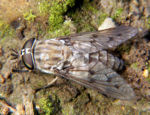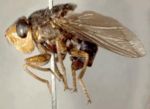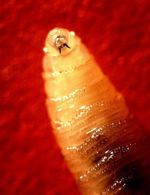Myiasis Producing Flies
| This article is still under construction. |
|
|
Introduction
Myiasis is the parasitism of living animals by dipteran larvae. Myiasis can be oligatory or facultative (optional) and is described as cutaneous, nasal or somatic.
Oestridae
- The larvae of Oestridae spp. are obligatory parasites
- The three important species of veterinary interest are Hypoderma, Oestrus and Gasterophilus
Hypoderma spp.
- Also known as warble flies
- Important cattle parasites
- Also parasitise horses, small ruminants and sometimes humans
- The two main species in cattle are H. bovis and H. lineatum
- H. diana parasitises deer
- Infestation is largely confined to the Northern Hemisphere
Recognition
- Large 13-15mm long
- Similar to bumble bees in appearance
- Yellow abdomen
- Band of black hairs
- One pair of wings
Life Cycle
- Adult flies emerge on warm, sunny days between June and August
- White eggs are laid around the belly and legs of the animal
- Eggs are attached to hairs by cement and a small terminal clasp
- H. lineatum lays a whole row of eggs as it approaches the animal stealthily
- H. bovis only deposits a single egg before the animal runs away ('gadding) as it makes a loud buzzing noise
- The adult lives for 3 weeks
- Females can lay several hundred eggs in their life
- A few days after eggs are laid, larvae emerge and crawl down the hairs into the hair follicles
- Larvae penetrate the skin through wounds made by biting flies
- Larvae migrate through the subcutaneous tissue towards the diaphragm
- Enzymatic secretions and mouth hooks aids larval migration
- After 3 months larvae reach winter resting sites where they remain from November to Feburary/March whilst moulting to the L2 stage
- Epidural fat in the spinal canal for H. bovis
- Wall of the oesophagus for H. lineatum
- Larvae then migrate back to the subcutis along the midline of the back where they bore a breathing hole through the skin and moult to the L3 stage
- Larvae are palpable as distinct swellings called warbles
- L3 larvae emerge after 4-10 weeks where they fall to the ground and pupate under loose vegetation
- Adult flies emerge from the pupa after one month where they copulate, lay eggs and die within two weeks
- H. lineatum are on the wing 6-8 weeks before H. bovis
- There is only one generation of warble flies per year
Pathogenesis
- Causes myositis
- Production losses
- Condemnation and down-grading of hides
- Reduced milk yield and reduced weight gain
- Injury from stock panic
- Trimmed meat losses from H. lineatum
- 'Butcher's Jelly' around warbles which is green due to mass eosinophil attraction
- Paraplegia resulting from:
- Toxin release
- Pressure on the spinal cord (H. bovis)
- Bloat from pressue on the oesophageal wall (H. lineatum)
Control
- Total eradication should be aimed for
- Old methods include popping out warbles
- But could lead to anaphylactic shock
- Ectoparasiticides
- Systemic organophosphorus insecticides in pour-on formula
- Avermectins and milbemycins in pour-on and injectible formulations
- Timing is crucial for treatment
- Larvae residing in winter resting sites, if killed, can lead to bloat and paraplegia
- It is safe to treat in the autumn before larvae reach their winter resting sites and in the spring when the warbles have migrated to the midline of the back
- Ivermectin can be given at any time without risking host infection as larval antigen is released much slower
Legislation in the UK
- 'Warble Fly Order 1978' requires all clinically affected animals to be treated
- Notifiable disease
- 'Warble Fly Infected Area Order 1983'
- For more information on the warble fly orders, see here
Oestrus ovis
- Also known as the sheep nasal bot fly
- Larvae parasitise the nasal chambers of sheep and goats
- Found in most sheep rearing areas of the world
Recognition
- 13-15mm long
- Grey colouring
- Black spots on abdomen
- Clear wings
- Larvae have distinct black bands on each body segment
Life Cycle
- Larvae are squirted into the nostils of sheep in a jet of liquid
- The larvae crawl caudally into the nasal cavity and feed on the nasal mucosa and mature before returning to the nostrils
- Larval development takes up to two months
- Larvae can overwinter in the nasal cavity if deposited late in the summer
- Once the larvae have developed they are sneezed out and pupate on the ground
- The adult fly emerges one months later
- Adult flies only live for 2-3 weeks
Pathogenesis
- Adult flies can annoyance
- Interrupts feeding
- Leads to a decreased weight gain
- Larvae cause nasal irritation, nasal discharge and sneezing
- Irritate the nasal mucosa with oral hooks and spines causing a viscous exudate to be produced from which they feed
- Heavy infestations lead to erosion of the bones in the sinuses (turbinate bones)
- Penetration of the brain leads to false gid (high stepping gait and incoordination)
Control
- Systemic insecticides can be used in heavy infestations
- In warmer countries, strategic prophylactic treatment can be used
Gasterophilus spp.
- Also known as the horse bot fly
- Obligate parasites of equids
- Spend most of lifecycle in equine stomach
- Cause little pathogenesic significance
- Three important species (in the UK)
- G. intestinalis which is the most common
- G. nasalis
- G. haemorrhoidalis which is rare
- Two other important veterinary species
- G. nigricornis
- G. inermis
Recognition
- Medium to large flies at 10-20mm long
- Look similar to drone bumble bees
- Body covered with dense yellow hair
- Dark coloured hairs produce a banding pattern
- Clear wings with brown patches
Life Cycle
- Adults are most active in late summer
- Eggs hatch spontaneously or are stimulated to hatch through an increase in warmth and moisture from the animal self-grooming
- G. intestinalis
- Creamy-white eggs
- 1-2mm in length
- Eggs laid in the hair of the shoulders and fore legs
- G. nasalis
- Eggs laid in the intermandibular area
- G. intestinalis
- G. haemorrhoidalis
- Eggs laid around the lips
- Larvae crawl into the mouth and penetrate the tissues of the buccal mucosa which takes a few weeks
- Larvae then emerge and are swallowed
- Larvae pass into the stomach and attach to the gastric mucosa
- Larvae are now known as bots
- Each species attaches to a specific part of the stomach
- G. intestinalis attaches to the cardiac region
- G. nasalis attaches to the pylorus
- After 10-12 months in the stomach, the larvae detach and are passed out in the faeces
- G. haemorrhoidalis attaches to the rectal mucosa before being passed out
- Larvae pupate on the ground
- Adults hatch after 1-2 months and survive for a few days up to two weeks
- Adults have non-functional mouthparts so cannot feed
- There is only one generation per year in temperate regions of the world
Pathogenesis
- Adult cause annoyance when egg laying
- Disturbance and panic can ensue
- Larvae cause a marked inflammatory reaction when attached to the gastric mucosa
- Ring like thickening around the base of each attached larvae
- Large numbes of larvae may interfere with the passage of food and action of the sphincters
- G. haemorrhoidalis can cause mild irritation to the rectal wall
- Host reaction to larvae in the mouth is minimal
Control
- Treatment of horses with insecticides over winter
- Breaks the life cycle as all the population are present as bots in the stomach
- If eggs are present in late summer, the horse's coat can be sponged with an insecticide
- Stimulates hatching
- Kills larvae
Dermatobia hominis
- Also called the human bot fly
- Larvae are important parasites of both humans and animals
- Specifically found in South America
Recongition
- Adult can grow up to 25mm in length
- Similar to Calliphora in appearance
- Blue/black
- Yellow/orange head and legs
- Larvae are dinstincive as they taper towards the posterior end
Life Cycle
- Eggs laid on blood sucking flies
- E.g. On mosquitos, which hatch when the mosquito next lands on a warm blooded animal
- Larvae penetrate skin causing painful swellings
- Larvae emerge after 35-42 days and fall to ground to pupate
- 4 month life cycle
Pathogenesis
- In humans, the larvae are msot often found in swellings on the head and limbs
- Larvae cause painful swellings and distress to cattle
- Larvae cause production losses
- Larvae exit wounds can increase the prevalence of attack by other myiasis flies
Calliphoridae
Recongition
Life Cycle
Pathogenesis
Control
Screw Worm Myiasis
- C. bezziana cause myiasis in both animals and humans
- Located mainly in tropical regions
- Larvae are obligate parasites
Recongition
- Similar to Calliphora
- Irridescent
- Clear wings
- Blue abdomen
- Longitudinal stripes on thorax
- Larvae have bands of spines
- Look like screws
Life Cycle
- Eggs laid in wounds or body cavities
- Larvae feed as colonies
- Larvae drop to the ground to pupate
Pathogenesis
- Spiracles are exposed as larvae feed which expands the wound
- Creates a foul smelling lesion
- Cause irritation and pyrexia
Control
- In the USA
- Mass eradication through the release of sterile males
- Currently only persists where flies have migrated across the Mexican border
- In Africa
- Introduced into Libya through the importation of infested livestock
- Sterile meales released
- Eradication occured in 1991
Maggot Debridement Therapy
- Human medicine
- Sterile Lucilla sericata maggots used to treat infected and necrotic wounds
- Larvae secrete proteolytic enzymes and antimicrobial agents into the wound
- Larvae do not burrow under the skin or attack healthy tissue
- Veterinary medicine
- Published reports rare
- Recently used successfully to treat a suppurative wound in a donkey that did not respond to conventional methods and surgery
Wohlfahrtia sp.
- Obligatory parasite
- Occurs in North America
- Parasite of mink and sometimes humans
Recongition
- Large 8-14mm long
- Pale grey
- Black stripes in thorax
- Black spots on abdomen
Life Cycle
- Larvae deposited directly onto host
- No egg stage
- Larvae moult twice on host then fall to ground to pupate
Pathogenesis
- Larvae penetrate intact skin
- Cause boil like swellings




